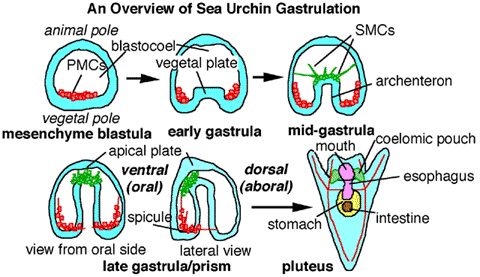






Sea urchin gastrulation begins with the ingression of primary, or skeletogenic, mesnenchy,me from the flattened epithelium at the vegetal pole of the embryos known as the vegetal plate. Following ingression of PMCs, there is a pause, and then the vegetal plate invaginates to form a stout cylinder called the archenteron. After another pause, secondary mesenchyme cells appear at the tip of the archenteron, and at about this time the archenteron begins to elongate across the blastocoel. Eventually the tip of the archenteron makes contact with the ectoderm near the animal pole. Meanwhile, the PMCs formed patterned arrays, and they ultimately secrete calcium carbonate-containing skeletal rods called spicules. The ventral (oral) ectoderm flattens, giving rise to what is known as the prism stage. Finally, the gut, ectoderm, and the skeleton undergo further obvious differentiation to make the pluteus larva.
